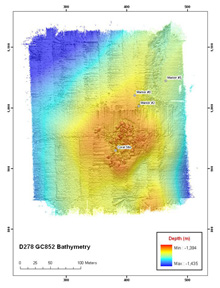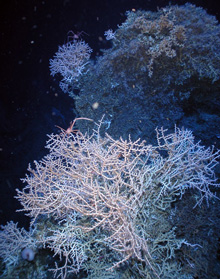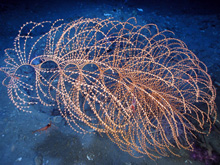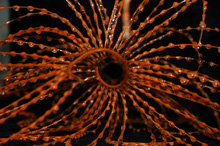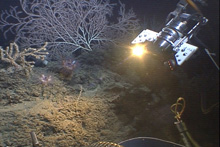After arriving at Green Canyon 852, the Jason remotely operated vehicle (ROV) group conducted a bathymetry survey of the site dubbed the "Coral Garden." At full resolution, the SM2000 multibeam mounted on the underside of the ROV enables scientists to spot objects as small as 0.5 meters. Click image for larger view and image credit.
This image shows Madrepora oculata (in the foreground) and Lophelia pertusa (in the upper-right corner). Click image for larger view and image credit.
Back to the Coral Garden
June 24, 2007
Erik Cordes
Harvard University
27° 6.56 N
91° 9.97 W
![]() A chirostylid crab hangs onto a large bamboo coral colony at the edge of the Coral Garden dive site. (Quicktime, 2.1 Mb.)
A chirostylid crab hangs onto a large bamboo coral colony at the edge of the Coral Garden dive site. (Quicktime, 2.1 Mb.)
![]() This is an up-close view of Madrepora, one of the hard coral species found at the Coral Garden. (Quicktime, 2.1 Mb.)
This is an up-close view of Madrepora, one of the hard coral species found at the Coral Garden. (Quicktime, 2.1 Mb.)
![]() Scientists noticed a impressive sea whip at the Green Canyon 852 site Coral Garden . (Quicktime, 1.1 Mb.)
Scientists noticed a impressive sea whip at the Green Canyon 852 site Coral Garden . (Quicktime, 1.1 Mb.)
During last year’s cruise, we visited a newly discovered site that contained a diversity of corals in a variety of shapes, sizes and colors: hard corals, sea fans, bamboo corals, and black corals, to name a few. We dubbed that site, which is located in Green Canyon 852 (GC 852), the "Coral Garden" Though last year’s Alvin dives were impacted by strong currents and complications with navigation, they provided an important foundation of information upon which to plan this year’s sampling activities. We hoped that this year’s return visit with the NOAA ship Ronald H. Brown and the Jason remotely operated vehicle (ROV) would provide an even better opportunity to characterize the full extent and composition of this area.
After completing two Jason ROV lowerings (for a total bottom time of 77 hours and 14 minutes), we accomplished many of our objectives and have come away with much of the information that we wanted.
The extent of the coral area and diversity of the associated fauna is much greater than we anticipated. In addition to the Enallopsammia rostrata deep-water coral that we collected this year, we now have samples from colonies of Lophelia pertusa and Madrepora oculata from this year’s dives. We believe that — at 1,410 meters — this may be the deepest record for Lophelia pertusa in the Gulf of Mexico.
These deep-water hard corals create reef-like structures like the hard corals in shallow water. However, unlike shallow-water hard corals that require sunlight to produce energy, deep-water hard corals are suspension-feeding animals. The corals at GC 852 cannot photosynthesize since they live below the photic zone, at depths to which light does not penetrate.A sea whip at the Coral Garden. Scientists spent several minutes examining the different organisms living in association with this single animal. Click image for larger view and image credit.
This close-up image centers on the central axis of this sea whip, after scientists collected its anterior end. The sample was taken back to the Ronald H. Brown. Click image for larger view and image credit.
A "grab" from the Jason science camera’s video of the Aquapix macro-camera taking close-up images of some of the organisms in the Coral Garden. Click image for larger view and image credit.
The structure created by the corals is inhabited by a number of other species, most of which we do not see at the nearby seeps. The lack of overlap between the deep-water (greater than 1,000 meters) chemosynthetic tubeworm and mussel communities and coral communities at similar depths is in line with our previous work at the upper-slope seep sites (about 500 m depth). There is very little similarity between these communities, even if they are separated by just a few meters! The species we find in tubeworm and mussel communities are far more tolerant of the high sulfide and methane and low oxygen conditions, typically found in seeps.
To supplement the physical samples from the coral communities at this site, we also spent considerable time taking both in-situ video and still imagery of the habitat. After the at-sea portion of this expedition is complete, we will spend numerous hours going through the imagery to learn more about the community ecology of the hard and soft corals at GC 852.
Please check back early next week after we have an opportunity to post several of our favorite still images and video clips.
































